
Alfonso XII, also known as El Pacificador or the Peacemaker, was King of Spain from 29 December 1874 to his death in 1885. After the 1868 Glorious Revolution deposed his mother Isabella II from the throne, Alfonso studied in Austria and France. His mother abdicated in his favour in 1870, and he returned to Spain as king in 1874 following a military coup against the First Spanish Republic. Alfonso died aged 27 in 1885, and was succeeded by his son, Alfonso XIII, who was born the following year.

Isabella II was Queen of Spain from 1833 until her deposition in 1868. She is the only queen regnant in the history of unified Spain.

Ferdinand VII was a King of Spain during the early 19th century. He reigned briefly in 1808 and then again from 1813 to his death in 1833. He was known to his supporters as el Deseado and to his detractors as el ReyFelón.
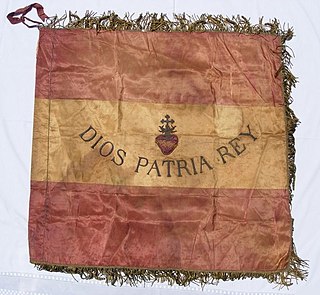
Carlism is a Traditionalist and Legitimist political movement in Spain aimed at establishing an alternative branch of the Bourbon dynasty – one descended from Don Carlos, Count of Molina (1788–1855) – on the Spanish throne.
The Carlist Wars were a series of civil wars that took place in Spain during the 19th century. The contenders fought over claims to the throne, although some political differences also existed. Several times during the period from 1833 to 1876 the Carlists — followers of Don Carlos (1788–1855), an infante, and of his descendants — rallied to the cry of "God, Country, and King" and fought for the cause of Spanish tradition against liberalism, and later the republicanism, of the Spanish governments of the day. The Carlist Wars had a strong regional component, given that the new order called into question region–specific law arrangements and customs kept for centuries.

Maria Christina of the Two Sicilies was Queen of Spain from 1829 to 1833 and queen regent of the kingdom from 1833, when her daughter became queen at age nine, to 1840. By virtue of her short marriage to King Ferdinand VII of Spain, she became a central character in Spanish history for nearly 50 years, thanks to introducing a bicameral model of government based on the Bourbon Restoration in France: the Spanish Royal Statute of 1834.
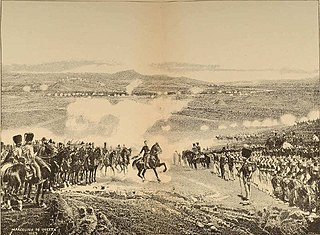
The First Carlist War was a civil war in Spain from 1833 to 1840, the first of three Carlist Wars. It was fought between two factions over the succession to the throne and the nature of the Spanish monarchy: The conservative and devolutionist supporters of the late king's brother, Carlos de Borbón, became known as Carlists (carlistas), while the progressive and centralist supporters of the regent, Maria Christina, acting for Isabella II of Spain, were called Liberals (liberales), cristinos or isabelinos. It is considered by some authors to be the largest and most deadly civil war of the period.
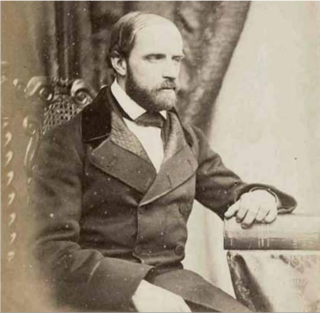
DonJuan Carlos María Isidro de Borbón, Count of Montizón was the Carlist claimant to the throne of Spain from 1860 to 1868, holder of the Legitimist claim to the throne of France from 1883 to 1887, and was a possible candidate to Mexican throne before the establishment of the Second Mexican Empire in the 1860s.
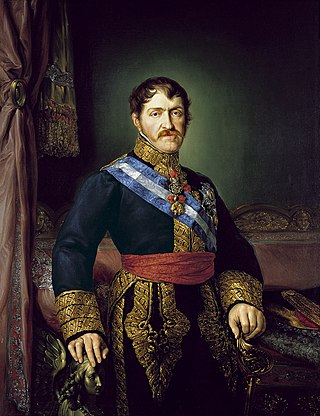
Don Carlos María Isidro Benito de Borbón was an Infante of Spain and the second surviving son of King Charles IV of Spain and his wife, Maria Luisa of Parma. As Charles V, he was the first of the Carlist claimants to the throne of Spain. He was a reactionary who stridently opposed liberalism in Spain and the assaults on the Catholic Church. He claimed the throne of Spain after the death of his older brother King Ferdinand VII in 1833. His claim was contested by liberal forces loyal to the dead king's infant daughter. The result was the bloody First Carlist War (1833–1840). Don Carlos had support from the Basque provinces and much of Catalonia, but lost the war and never became king. His heirs continued the traditionalist cause, fought two more Carlist wars and were active into the mid-20th century, but never obtained the throne.

Spain in the 19th century was a country in turmoil. Occupied by Napoleon from 1808 to 1814, a massively destructive "liberation war" ensued. Following the Spanish Constitution of 1812, Spain was divided between the 1812 constitution's liberal principles and the absolutism personified by the rule of Ferdinand VII, who repealed the 1812 Constitution for the first time in 1814, only to be forced to swear over the constitution again in 1820 after a liberal pronunciamiento, giving way to the brief Trienio Liberal (1820–1823).

Francisco Serrano Domínguez Cuenca y Pérez de Vargas, 1st Duke of la Torre, Grandee of Spain, Count of San Antonio was a Spanish marshal and statesman. He was Prime Minister of Spain in 1868–69 and regent in 1869–70.
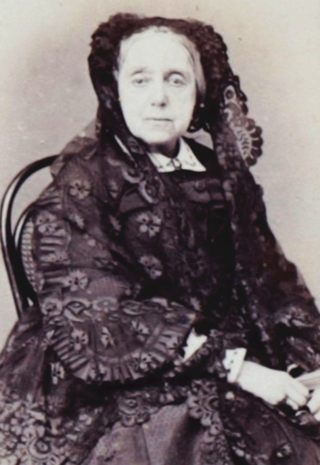
Infanta Maria Teresa of Braganza was the firstborn child of John VI of Portugal and Carlota Joaquina of Spain. From 1828 to 1834, she was heiress presumptive to the Portuguese throne.

Maria Isabella of Spain was an infanta of Spain and queen consort of the Two Sicilies by marriage to Francis I of the Two Sicilies.

Carlos Luis María de Borbón was the Carlist claimant to the throne of Spain under the name Carlos VI after his father's renunciation in 1845. He used the title Conde de Montemolín.
The Moderate Party or Moderate Liberal Party was one of the two Spanish political parties that contended for power during the reign of Isabel II. Like the opposing Progressive Party, it characterised itself as liberal and dynasticist; both parties supported Isabel against the claims of the Carlists.
There were numerous political parties and factions in Isabelline Spain. Some of them are known by multiple names, and in many cases the lines between these were fluid over time, both in terms of individuals moving from one party or faction to another and in terms of parties or factions changing their stances. Many of these factions are subgroups of parties, and groupings sometimes overlapped. Many factions were based on little more than political clientelism.

The Ominous Decade is a term for the last ten years of the reign of King Ferdinand VII of Spain, dating from the abolition of the Spanish Constitution of 1812, on 1 October 1823, to his death on 29 September 1833.

The Reign of Isabella II of Spain has been seen as being essential to the modern history of Spain. Her reign spanned the death of Ferdinand VII of Spain in 1833 until the Spanish Glorious Revolution of 1868, which forced the Queen into exile and established a liberal state in Spain.

The Royal Expedition, also known as Don Carlos' Expedition, was an 1837 operation in the late stages of the First Carlist War undertaken by the Carlist insurgents. Marking the highest point of Carlist control, it ended with a humiliating defeat and laid the groundwork for the end of the war in 1839.

Isabella II of Spain was barely three years of age when her father Ferdinand VII of Spain died on 29 September 1833. Her minority age was marked first by the regency of her mother Maria Christina of the Two Sicilles and then under General Baldomero Espartero, covering almost ten years of her reign, until 23 July 1843, when Isabella was declared to be of age.















